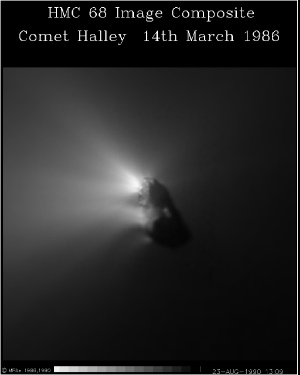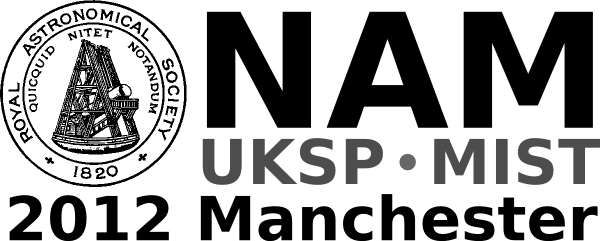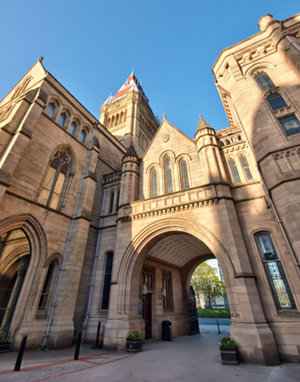UK-Germany National Astronomy Meeting NAM2012
Jupiter helps Halley's Comet give us more spectacular meteor displays
Royal Astronomical Society press release
RAS 12/16 (NAM 7)
Tuesday 27 March 2012

The nucleus of Halley's Comet, taken by the Halley Multicolour Camera on board ESA's Giotto spacecraft in 1986. Credit MPS Germany/H.U. Keller/ESA
The dramatic appearance of Halley's comet in the night sky has been observed and recorded by astronomers since 240 BC. Now a study shows that the orbital influences of Jupiter on the comet and the debris it leaves in its wake are responsible for periodic outbursts of activity in the Orionid meteor showers. The results will be presented by Aswin Sekhar at the National Astronomy Meeting in Manchester on Tuesday 27th March.
Halley's comet orbits the Sun every 75-76 years on average. As its nucleus approaches the Sun, it heats up and releases gas and dust that form the spectacular tail. This outgassing leaves a trail of debris around the orbit.
When the Earth crosses Halley's path - twice per orbit - dust particles (meteoroids) burn up in the Earth's atmosphere and we see meteor showers: the Orionids in October and the Eta Aquariids in May. Previous research has suggested that Orionid meteoroids have at times fallen into 'resonances' with Jupiter's orbit - a numerical relationship that influences orbital behaviour. Sekhar's new study suggests that Halley itself has been in resonances with Jupiter in the past, which in turn would increase the chances of populating resonant meteoroids in the stream. The particles ejected during those times experience a tendency to clump together due to periodic effects from Jupiter.
"This resonant behaviour of meteoroids means that Halley's debris is not uniformly distributed along its orbital path. When the Earth encounters one of these clumps, it experiences a much more spectacular meteor shower than usual," said Sekhar, of Armagh Observatory.
Sekhar has modelled Halley's orbital evolution over more than 12 000 years into the past and 15 000 years into the future. The model suggests that from 1404 BC to 690 BC, Halley was trapped in a 1:6 resonance with Jupiter (in which Halley completed one orbit for every six orbits of Jupiter around the Sun). Later, from 240 BC to 1700 AD, the comet's orbit had a 2:13 relationship with Jupiter's orbit. Debris deposited during these two periods can be directly attributed to heightened activity in the Orionid meteor showers in some years. Sekhar's work suggests that the unusual Orionid outburst observed in 1993 was due to 2:13 resonant meteoroids ejected from Halley around 240 BC. He predicts that the next similar display of meteors from this 2:13 resonance will be in 2070 AD.
"The real beauty of this area of science lies in the convergence of cometary physics and orbital dynamics. The close correlation between historical records from ancient civilisations and the predictions using modern science make it even more elegant," said Sekhar. He added, "There are enough unsolved problems pertaining to Halley and its meteor streams to keep us occupied till the next apparition of the comet in 2061!"
IMAGES
- The nucleus of Halley's Comet, taken by the Halley Multicolour Camera on board ESA's Giotto spacecraft in 1986. Credit MPS Germany/H.U. Keller/ESA. http://www.ras.org.uk/images/stories/NAM/2012/halley.gif
- Image of 2007 Orionids, showing Orion constellation in the backdrop. Credit: S. Quirk http://www.ras.org.uk/images/stories/NAM/2012/orionids.jpg
MEDIA CONTACTS
NAM 2012 Press Office (0900 - 1730 BST, 27-29 March; 0900 - 1630 BST 30 March)
Room 3.214
University Place building
University of Manchester
Manchester
UK
Tel: +44 (0)161 306 7313
Dr Robert Massey
Royal Astronomical Society
Mob: +44 (0)794 124 8035
Email: rm@ras.org.uk
Anita Heward
Royal Astronomical Society
Mob: +44 (0)7756 034 243
Email: anitaheward@btinternet.com
Dr Klaus Jaeger
Pressereferent / Press Officer im Vorstand der Astronomischen Gesellschaft
Tel: +49 6221 528 379
Email: pressereferent@astronomische-gesellschaft.de
Dan Cochlin
Media Officer (Faculty of Engineering and Physical Sciences)
University of Manchester
Tel: +44 (0)161 275 8387
Email: daniel.cochlin@manchester.ac.uk
SCIENCE CONTACTS
Aswin Sekhar
Armagh Observatory
Armagh
Northern Irelandv
Tel: +44- 7514265321
Email: aswinsek@gmail.com / asw@arm.ac.uk
On 27th March, Sekhar can be contacted through the NAM 2012 press office.
NOTES FOR EDITORS
NAM 2012
Bringing together more than 900 astronomers and space scientists, the National Astronomy Meeting (NAM 2012) will take place from 27-30 March 2012 in the University Place conference centre at the University of Manchester in the UK. The conference is a joint meeting of the Royal Astronomical Society (RAS) and the German Astronomische Gesellschaft (AG) and is held in conjunction with the UK Solar Physics (UKSP: www.uksolphys.org) and Magnetosphere Ionosphere Solar Terrestrial (MIST: www.mist.ac.uk) meetings. NAM 2012 is principally sponsored by the RAS, AG, STFC and the University of Manchester.
The Royal Astronomical Society
The Royal Astronomical Society (RAS: www.ras.org.uk), founded in 1820, encourages and promotes the study of astronomy, solar-system science, geophysics and closely related branches of science. The RAS organises scientific meetings, publishes international research and review journals, recognizes outstanding achievements by the award of medals and prizes, maintains an extensive library, supports education through grants and outreach activities and represents UK astronomy nationally and internationally. Its more than 3500 members (Fellows), a third based overseas, include scientific researchers in universities, observatories and laboratories as well as historians of astronomy and others.
The Astronomische Gesellschaft (AG)
The Astronomische Gesellschaft (AG: www.astronomische-gesellschaft.de), founded in 1863, is a modern astronomical society with more than 800 members dedicated to the advancement of astronomy and astrophysics and the networking between astronomers. It represents German astronomers, organises scientific meetings, publishes journals, offers grants, recognises outstanding work through awards and places a high priority on the support of talented young scientists, public outreach and astronomy education in schools.
The Science and Technology Facilities Council
The Science and Technology Facilities Council (STFC: www.stfc.ac.uk) is keeping the UK at the forefront of international science and tackling some of the most significant challenges facing society such as meeting our future energy needs, monitoring and understanding climate change, and global security. The Council has a broad science portfolio and works with the academic and industrial communities to share its expertise in materials science, space and ground-based astronomy technologies, laser science, microelectronics, wafer scale manufacturing, particle and nuclear physics, alternative energy production, radio communications and radar. It enables UK researchers to access leading international science facilities for example in the area of astronomy, the European Southern Observatory.
Jodrell Bank Centre for Astrophysics
The Jodrell Bank Centre for Astrophysics (JBCA: www.jb.man.ac.uk) is part of the School of Physics & Astronomy at the University of Manchester. JBCA is split over two main sites: the Alan Turing Building in Manchester and the Jodrell Bank Observatory in Cheshire. At Jodrell Bank Observatory, the new Jodrell Bank Discovery Centre is a key focus for our work in public engagement and education. Jodrell Bank is a world leader in radio astronomy-related research and technology development with a research programme extending across much of modern astrophysics. The group operates the e-MERLIN national radio astronomy facility and the iconic Lovell Telescope, hosts the UK ALMA Regional Centre Node and is home to the international office of the SKA Organisation. Funded by the University, the Science & Technology Facilities Council and the European Commission, it is one of the UK's largest astrophysics research groups.





